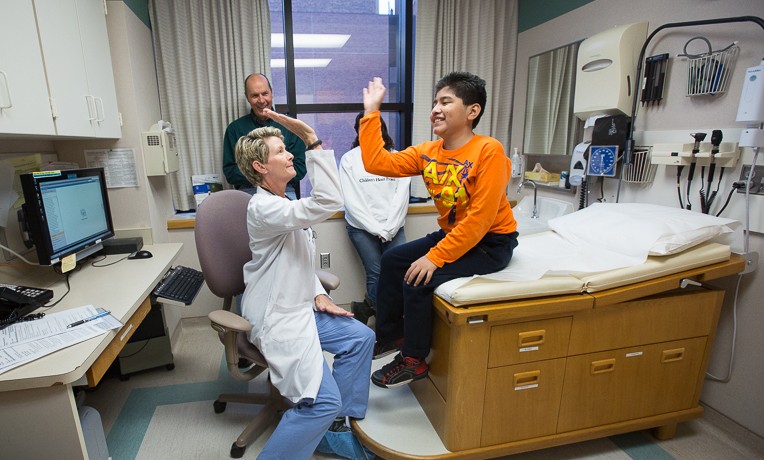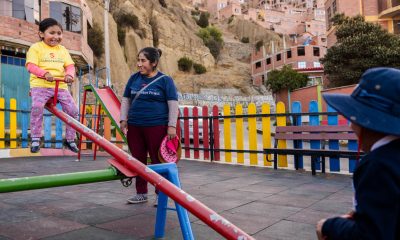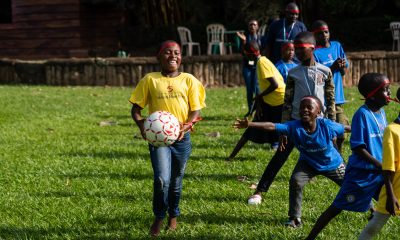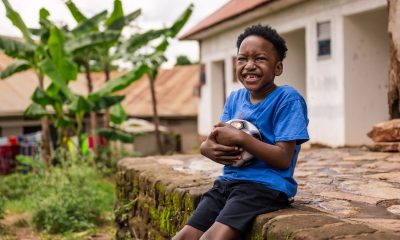In Bolivia, they would have died. In Minnesota, they found life.
Upon first appearances, they don’t have a lot in common.
Jheens is 11 years old. He lives with his parents and older sister in his aunt’s apartment in Santa Cruz, Bolivia. He attends school and hopes to be a doctor one day. His father works to provide for their family, while his mother devotes all her time to caring for Jheens.
Rodrigo is 15 years old. He lives with his parents and two older sisters in a mud brick house close to Salar de Uyuni, Bolivia, the largest salt flat in the world. He walks to school each morning as his parents and older siblings (five in total) head to their field to farm quinoa.
Jheens comes from a middle class family and the most populated city in Bolivia. Rodrigo’s family lives off their meager farm income in a unique area high in the Altiplano. Had their lives taken a normal path, the boys would have never met each other. But theirs is a different path.
Both boys were born with a heart defect called Tetralogy of Fallot, which results in low oxygenation of blood. In the U.S., Tetralogy of Fallot is usually repaired within the first year of life, but in Bolivia, surgery is risky and often unavailable. Children with the condition are usually blue. They also suffer from heart murmurs, lack of weight gain and physical development, tiredness, and clubbed digits. Left untreated, Tetralogy of Fallot eventually results in death.
Jheens’ Story
At Jheens’ 1-month checkup, he received a clean bill of health. But his grandmother thought that something wasn’t right. She urged her daughter to take him back to the clinic. There, doctors told her to take him to the hospital. He stayed for three weeks and was diagnosed with a heart defect.
Jheens’ mother, Reina, checked him out of the hospital and began looking for a specialist in Santa Cruz. She was told that no one performed open heart surgery in the city. Disappointed, she sought advice from one of her acquaintances, a cardiologist. He prescribed medication for Jheens that helped him to grow and breathe easier.
“I had faith that he was healing,” Reina said.
But as Jheens grew, he got sick often, and his recovery was slow. Doctors told Reina that Jheens needed open heart surgery to live. She pursued doctors from other countries but was unable to find anyone to accept Jheens’ case.
As the years passed, Jheens’ condition worsened. When he was 7, he began tiring easily, and his lips and fingernails began turning purple. Eventually, he had to use a wheelchair to move around.
“He used to dance when he was a child, but not anymore,” Reina said.
Because of his condition, most schools were wary of accepting him. Reina decided to enroll him in private school where she could go with him every day.
“When I remember that, that’s why I’m crying,” she said. “It’s hard for me to think about that.”
Jheens recalled that his mother wouldn’t let him play with friends because she was afraid that he would get too tired. She told him he had to have his heart fixed first.
Reina continued to look for organizations or doctors that would accept Jheens for surgery. Eventually she met a doctor who introduced her to the Children’s Heart Project in Bolivia. That’s when life began to change.
Rodrigo’s Story
When Rodrigo was two months old, his mother, Nelida, noticed that his heartbeat was fast any time she touched his chest and that he sweated a lot.
“I told my husband, ‘I think something’s wrong with our baby,’ and he said, ‘Ah, come on, you’re crazy. Babies are just like that,’” she said. “But I noticed something.”

(Top) Rodrigo’s hand, purple with clubbed fingers, before surgery. (Bottom) Rodrigo’s hand after surgery.
Although Nelida knew something was wrong, she didn’t live near any clinics or hospitals, and without the support of her husband, she didn’t know where to turn. Rodrigo continued to grow, but by 5 years old, his hands had started to turn purple.
Finally, when Rodrigo was 8, Nelida gathered enough money to take the 12-hour bus ride to La Paz. She wanted him to finally see a doctor. But when they arrived, it was late, so the doctor was no longer available. Nelida didn’t have money to stay somewhere for the night, so she and Rodrigo boarded the bus back home without having seen the doctor.
Rodrigo’s breathing and mobility continued to deteriorate. He said that he lived about three blocks from his school. After each block, he had to stop for a five-minute break to catch his breath. It took him about 30 minutes to complete the walk. He often had to put his head down, and his hands were always cold.
In school, he couldn’t play with the other children because he was too tired. When they did line formations, he stayed seated. He said that sometimes he was even too tired to sit. In desperation, he prayed for healing.
“I was wondering, ‘Why am I not healthy?’” he said. “‘Why can I not play with them?’”
When Rodrigo was 14, he started complaining about pain in his back. His health was failing, and Nelida knew she had to do something for him. Her brother now lived in La Paz, so she visited him. He knew of a cardiologist and took Rodrigo. For 14 years, Rodrigo had lived without knowing why he was sick. Finally, the doctor diagnosed him with a heart defect and pointed them to the Children’s Heart Project.
“Rodrigo’s condition at presentation was so severe probably because of a combination of things,” said Dr. Allison Cabalka, a pediatric cardiologist who eventually treated Rodrigo. “He was 15 years of age, and things progress more the older you get, and he was also living at very high altitude.”
Throughout his life, Rodrigo had dreamed of a plane, despite having never seen one. In his dreams, the plane brought healing to him. Finally, his dream was coming true.
Coming to America
Both Jheens and Rodrigo were accepted for surgery at the hospital in Minnesota where Dr. Cabalka works. Neither had left Bolivia before. They and their mothers made the long flight with an interpreter and arrived in Minnesota on October 12.
“Getting out of there, it was like I was going to heaven,” Reina said about flying to the surgeries.
On October 20, Jheens underwent surgery, and two days later, Rodrigo followed. Both of the boys and their moms were nervous. Rodrigo was unsure that he even wanted to go through with it.
“The interpreters talked to him about the future and how much better it would be to have a full life,” said Dave Verburg, a former Children’s Heart Project host father who spent many days with Rodrigo in the hospital. “And he became strong after that. And not too long after that, he asked me to stay with his mom. It’s so unfamiliar to her; she was really scared. He kind of got strong for his mom.”
During Rodrigo’s surgery, Nelida said she cried a lot and prayed to God. She said that without God, Rodrigo never would have been healthy.
Reina said that during Jheens surgery, she went to the bathroom, fell to her knees, and outstretched her arms. She said she felt a presence around her, and God gave her peace.
“That was the most beautiful part of that day.”

Jheens rides a John Deere lawn mower as his host parents, Curt and Beth, watch him learn new skills.
Both boys survived their surgeries, and the change in their appearances was immediately noticeable. Both boys’ lips and fingernails were pink. They were able to explore their new abilities soon afterward.
“I’m very happy because now I can walk,” Jheens said. “Yesterday I was running.”
A Future Different than Planned
On November 19, Jheens returned home to Santa Cruz. Rodrigo will follow in a few weeks.
Life for both boys has already dramatically improved. Nelida is thrilled that her son is going home as a healthy man. Before Jheens’ surgery, Reina did everything for her son, from cutting his meat to putting on his shoes. Her life was defined by caring for him. Now she’s learning to let go.
The boys both have hopes for their own futures too. Jheens said that when he grows up, he wants to be a doctor like the surgeon who repaired his heart. He has already learned all the bones of the body. In the more immediate future, Jheens is thinking about the holidays.
“I want to buy Christmas things and decorate the home,” he said.
Before his surgery, Jheens had never been to a store. His mother always told him he was too sick to go. He’s never been able to decorate or buy gifts. Reina is also excited that Jheens is now healthy enough to walk. She said she plans to take him to the market to buy potatoes and onions because the bags are heavy and he can help her carry them now.
“Now that I see that Jheens is healthy, ‘Is this a dream? Somebody pinch me,’” Reina said. “I know God used doctors’ hands to heal him. Life is going to be wonderful, even more than it was.”
Rodrigo hasn’t yet decided on a career—until recently, he didn’t think he’d live long enough to have one. But he does know what he wants to do when he returns home. He’s ready to join his school’s band as a trumpet player.
“It’s going to be different,” he said. “I’m going to have a lot of air in my lungs.”
He said he also wants to play soccer and help his parents in their quinoa fields. He has spent most of his life watching his five older siblings do things that he hasn’t been able to do. He’s ready to finally join them.
The outlook for the boys is drastically different than it was even a few weeks ago. Before the surgeries, their mothers were afraid to plan too far into the future. They didn’t know how long they would have their sons.
“Rodrigo probably was within a few years of dying from his heart condition,” said Dr. Cabalka. “And Jheens probably wasn’t that far behind him.”
During the surgeries, the mothers and their sons relied heavily on God to get through. Nelida prayed ceaselessly, Reina felt the presence of God, and both boys admitted God’s role in their surgeries. As they return home, they have this hope in a Savior to carry with them. Reina said she would tell everyone what had happened.
“Before, I felt like my heart was beating very fast, but now it’s beating normally,” Rodrigo said. “God healed me. God is the one that healed me and gave me a new heart.”



























































